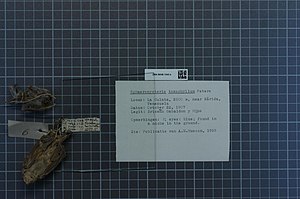Umbrella bat
| Umbrella bat | ||||||||||||
|---|---|---|---|---|---|---|---|---|---|---|---|---|

Umbrella bat ( Sphaeronycteris toxophyllum ) |
||||||||||||
| Systematics | ||||||||||||
|
||||||||||||
| Scientific name of the genus | ||||||||||||
| Sphaeronycteris | ||||||||||||
| Peters , 1882 | ||||||||||||
| Scientific name of the species | ||||||||||||
| Sphaeronycteris toxophyllum | ||||||||||||
| Peters, 1882 |
The umbrella bat ( Sphaeronycteris toxophyllum ) is a rare species of bat in the leaf-nosed family (Phyllostomidae). It is the only representative of the thus monotypical genus Sphaeronycteris .
The species reaches a head-torso length of about 57 mm, a forearm length of about 39 mm and a weight of about 15 g. The rudimentary tail is not externally visible. The fur is a cinnamon brown color on the top with scattered white hairs mostly concentrated on the center of the back. The fur is light brown on the underside. The fleshy flap of skin on the nose is more like a broad horn than a leaf found on most other leaf noses. The horn is more clearly developed in males than in females. The facial features are strongly reminiscent of the type known as the old man's face ( Centurio senex ). In Sphaeronycteris toxophyllum , the skin folds are not so clearly pronounced. Furthermore, this bat has a third molar in both halves of the lower jaw, which is missing in Centurio senex .
Sphaeronycteris toxophyllum lives in northern South America east of the Andes . The distribution area extends from Colombia and Venezuela to the east of Peru , to the north of Bolivia and to western Brazil . Individuals were caught in the lowlands and in mountains up to 2250 meters above sea level. The species prefers moist evergreen forests as a habitat. In dry regions, she can be found in gallery forests . It can adapt to agricultural areas.
Almost nothing is known about the way of life. Fruits are believed to serve as food. A female caught in Peru in 1983 was pregnant.
The World Conservation Union (IUCN) lists visored bat with "insufficient data" ( Data Deficient ) and holds a subsequent classification as ( "low risk" Near Threatened ) possible.
Individual evidence
- ↑ Don E. Wilson , DeeAnn M. Reeder (Ed.): Mammal Species of the World . A taxonomic and geographic Reference . 3. Edition. 2 volumes. Johns Hopkins University Press, Baltimore MD 2005, ISBN 0-8018-8221-4 (English, Sphaeronycteris ).
- ↑ a b Ronald M. Nowak: Walker's Mammals of the World. Volume 1. 6th edition. 1999, p. 403, Sphaeronycteris .
- ↑ a b c Sphaeronycteris toxophyllum in the IUCN Red List of Threatened Species 2014.3. Listed by: Tavares, V. & Lewis, D., 2008. Retrieved May 21, 2015.